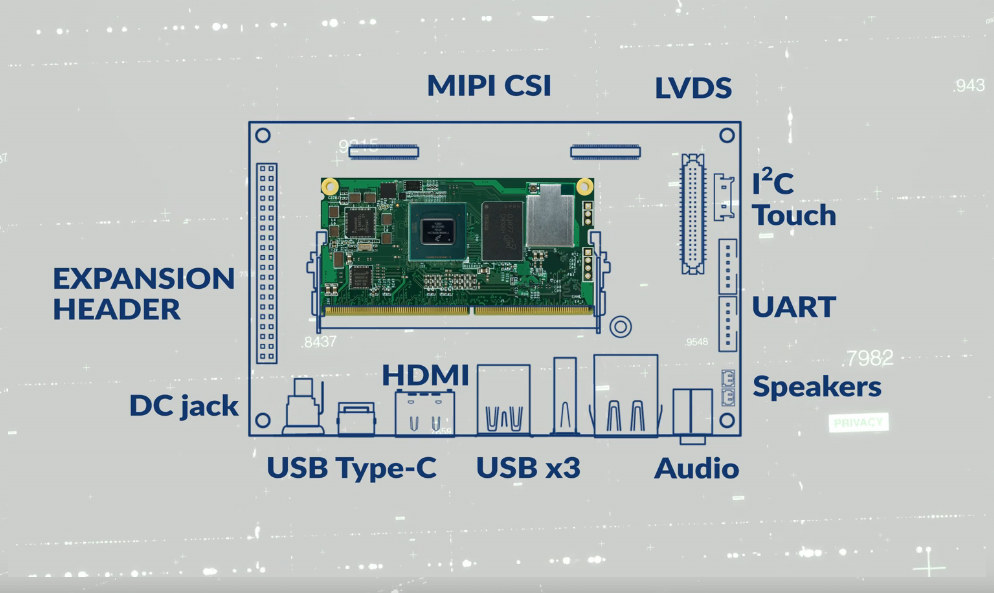TechNexion Wandboard Dual was one of the first Freescale i.MX 6 single board computers when it launched in early 2013 and the company has introduced a few more models over the years including Wandboard QuadPlus in 2017.
TechNexion is now working on a new version called Wandboard 8MPLUS powered by the recently announced NXP i.MX 8M Plus SoC that features a built-in 2.3 TOPS NPU for AI acceleration.
Wandboard 8MPLUS preliminary specifications:
- EDM System-on-Module
- SoC – NXP i.MX8M Plus quad-core Arm Cortex-A53 processor @ up to 1.8 GHz, Arm Cortex-M7 real-time core @ up to 800 MHz, Vivante GC7000UL 3D GPU, Vivante GC520L 2D GPU, HiFi 4 audio DSP, and 2.3 TOPS Neural Processing Unit (NPU)
- System Memory – 2GB or 4GB LPDDR4
- Storage – 32GB eMMC flash
- Video Decode – HD (1080p +720p)
- Video Encode – 1080p60 H.265, H.264
- 260-pin EDM Type G board-to-board connector
- Debugging – JTAG Interface by through holes
- PMIC – NXP PCA9450
- Carrier Board
- Storage – MicroSD slot
- Display Interfaces
- HDMI 2.0a Tx with eARC support
- Dual-channel LVDS expansion header, I2C touch connector
- Audio – CTIA compliant 3.5mm audio jack, speaker connectors
- Camera – Dual 4-lane MIPI CSI
- Connectivity
- Gigabit Ethernet (RJ45) via Atheros AR8035 Gigabit transceiver
- IMX8M-Plus-4G model only
- Dual-band 802.11 a/b/g/n/ac Wi-Fi 5 and Bluetooth via Qualcomm Atheros QCA9377
- MHF4 connector for antenna
- Optional 4G LTE via M.2 card and Nano-SIM card slot
- USB – 3x USB 3.0 Host ports, 1x USB Type-C port
- Serial – 2x UART
- Expansion
- M.2 slot
- Expansion header with I²S, SDIO, CAN, UART, SPI, I²C, PWM, GPIO, etc..
- Misc – Boot Select & Reset buttons, power LED
- Power Supply – Via DC jack or USB-C port
- Temperature Range – Commercial: 0° to +50° C
- Certification and Compliance
- USA – FCC ID: 2AKZA-QCA9377
- Canada – IC: 22364-QCA9377
- Japan – TELEC: 201-180629
- European Union – EN 55032 / EN 55024; EN 300 328 v2.1.1; EN 301 893 v2.1.1
- Australia/New Zealand – RCM
- Certification – Compliant with RoHS / REACH directives
The company will officially support Android and Yocto Linux for the board, but if history is any guide, many other operating systems may eventually be supported as was the case for Wandboard.
The highlight of the board is really the NPU inside NXP i.MX 8M Plus processor, so just after providing an overview of the board, Marcel vandenHeuvel, TechNexion CEO, showcases an AI demo with Tensorflow Lite where object recognition is done in around 8ms when the NPU is enabled or about twenty times faster than with the CPU alone.
The demo runs on a full-featured i.MX 8M Plus development board as Wandboard 8MPLUS SBC is quite not quite available yet.
But TechNexion is now taking pre-orders for two variants of the board:
- Wandboard IMX8M-Plus-2G with 2GB LPDDR4 for $134.00
- Wandboard IMX8M-Plus-4G with 4GB LPDDR4, Wi-Fi and Bluetooth connectivity for $159
There’s no clear ETA, and the company promises to ship the board as soon as NXP i.MX 8M Plus processor is mass-produced. The latter often happens roughly one year after the announcement, so around January 2021. Bear in mind that processor launch timing is highly variable, so it could be a few months earlier or later.

Jean-Luc started CNX Software in 2010 as a part-time endeavor, before quitting his job as a software engineering manager, and starting to write daily news, and reviews full time later in 2011.
Support CNX Software! Donate via cryptocurrencies, become a Patron on Patreon, or purchase goods on Amazon or Aliexpress





